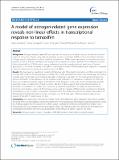Files in this item
A model of estrogen-related gene expression reveals non-linear effects in transcriptional response to tamoxifen
Item metadata
| dc.contributor.author | Lebedeva, Galina | |
| dc.contributor.author | Yamaguchi, Azusa | |
| dc.contributor.author | Langdon, Simon P. | |
| dc.contributor.author | Macleod, Kenneth | |
| dc.contributor.author | Harrison, David J. | |
| dc.date.accessioned | 2013-07-29T11:31:04Z | |
| dc.date.available | 2013-07-29T11:31:04Z | |
| dc.date.issued | 2012-11-08 | |
| dc.identifier | 61417578 | |
| dc.identifier | 312ba224-53ed-4057-816c-b5fea3869558 | |
| dc.identifier | 000314921100001 | |
| dc.identifier | 84868513344 | |
| dc.identifier.citation | Lebedeva , G , Yamaguchi , A , Langdon , S P , Macleod , K & Harrison , D J 2012 , ' A model of estrogen-related gene expression reveals non-linear effects in transcriptional response to tamoxifen ' , BMC Systems Biology , vol. 6 , 138 . https://doi.org/10.1186/1752-0509-6-138 | en |
| dc.identifier.issn | 1752-0509 | |
| dc.identifier.other | ORCID: /0000-0001-9041-9988/work/64034256 | |
| dc.identifier.uri | https://hdl.handle.net/10023/3887 | |
| dc.description | SynthSys is a Centre for Integrative Systems Biology (CISB) funded by BBSRC and EPSRC, reference BB/D019621/1. | en |
| dc.description.abstract | Background: Estrogen receptors alpha (ER) are implicated in many types of female cancers, and are the common target for anti-cancer therapy using selective estrogen receptor modulators (SERMs, such as tamoxifen). However, cell-type specific and patient-to-patient variability in response to SERMs (from suppression to stimulation of cancer growth), as well as frequent emergence of drug resistance, represents a serious problem. The molecular processes behind mixed effects of SERMs remain poorly understood, and this strongly motivates application of systems approaches. In this work, we aimed to establish a mathematical model of ER-dependent gene expression to explore potential mechanisms underlying the variable actions of SERMs. Results: We developed an equilibrium model of ER binding with 17 beta-estradiol, tamoxifen and DNA, and linked it to a simple ODE model of ER-induced gene expression. The model was parameterised on the broad range of literature available experimental data, and provided a plausible mechanistic explanation for the dual agonism/antagonism action of tamoxifen in the reference cell line used for model calibration. To extend our conclusions to other cell types we ran global sensitivity analysis and explored model behaviour in the wide range of biologically plausible parameter values, including those found in cancer cells. Our findings suggest that transcriptional response to tamoxifen is controlled in a complex non-linear way by several key parameters, including ER expression level, hormone concentration, amount of ER-responsive genes and the capacity of ER-tamoxifen complexes to stimulate transcription (e. g. by recruiting co-regulators of transcription). The model revealed non-monotonic dependence of ER-induced transcriptional response on the expression level of ER, that was confirmed experimentally in four variants of the MCF-7 breast cancer cell line. Conclusions: We established a minimal mechanistic model of ER-dependent gene expression, that predicts complex non-linear effects in transcriptional response to tamoxifen in the broad range of biologically plausible parameter values. Our findings suggest that the outcome of a SERM's action is defined by several key components of cellular micro-environment, that may contribute to cell-type-specific effects of SERMs and justify the need for the development of combinatorial biomarkers for more accurate prediction of the efficacy of SERMs in specific cell types. | |
| dc.format.extent | 22 | |
| dc.format.extent | 1983058 | |
| dc.language.iso | eng | |
| dc.relation.ispartof | BMC Systems Biology | en |
| dc.subject | Estrogen receptor | en |
| dc.subject | Cancer | en |
| dc.subject | Tamoxifen | en |
| dc.subject | SERM | en |
| dc.subject | Mathematical model | en |
| dc.subject | Global sensitivity analysis | en |
| dc.subject | R Medicine | en |
| dc.subject | SDG 3 - Good Health and Well-being | en |
| dc.subject.lcc | R | en |
| dc.title | A model of estrogen-related gene expression reveals non-linear effects in transcriptional response to tamoxifen | en |
| dc.type | Journal article | en |
| dc.contributor.institution | University of St Andrews. School of Medicine | en |
| dc.identifier.doi | 10.1186/1752-0509-6-138 | |
| dc.description.status | Peer reviewed | en |
This item appears in the following Collection(s)
Items in the St Andrews Research Repository are protected by copyright, with all rights reserved, unless otherwise indicated.

